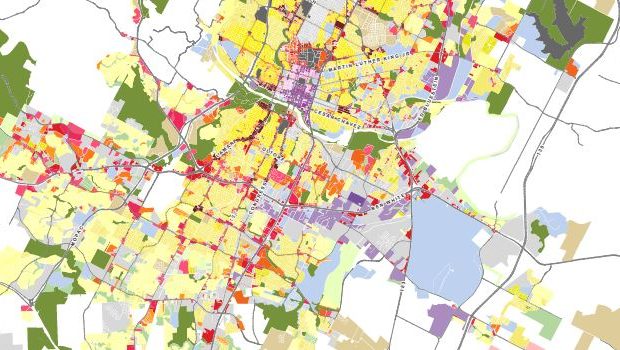As deadline nears, CodeNEXT capacity figures still in question
Friday, March 30, 2018 by
Joseph Caterine The land use commissions received a briefing on the affordability implications of the third and final draft of CodeNEXT Tuesday night, with only a few weeks left before they turn in their official recommendations to City Council. Consultants and staff shared the most up-to-date projections on how many affordable units would be facilitated by adopting the proposed development code overhaul, but some commissioners remained skeptical about the numbers.
In prior presentations, representatives of Fregonese Associates and ECONorthwest had reiterated that their calculations reflected the overall housing capacity for the city and not how many units will end up being built. The latest figures from the consultants estimate that CodeNEXT Draft 3 will make possible 287,000 units over the next 10 years, over twice the goal of 135,000 set by the Strategic Housing Blueprint approved by City Council last April.
John Fregonese said at the meeting that the 2:1 ratio of capacity to constructed units was ideal. “Not having enough capacity puts you at risk of housing price increases,” he said.
The Draft 3 capacity total exceeds the Draft 2 total by about 12,000 units, and part of the reason for the growth, explained Ian Carlton with ECONorthwest, is the extra acreage permitted for the city’s density bonus programs, including the proposed citywide Affordable Housing Bonus Program.
Several commissioners challenged the conclusions of the presentation, with some saying the projections were too high and others saying they were too low. Zoning and Platting Commissioner Jim Duncan said that he appreciated the tool Fregonese Associates had developed for the Planning Commission that allows commissioners to change different variables in order to see the influence on capacity.
At the same time, Duncan said that the consultants’ program missed out on some factors in its calculations. For example, the capacity projected in the Hill Country was not going to happen, in his opinion, because of the terrain and other constraints in that area. “I know some people here want big numbers. I want real numbers,” Duncan said.
Planning Commissioner James Shieh also expressed confusion concerning the base forecast of 135,000. He cited city demographer Ryan Robinson’s presentation from a past meeting that forecasted only 70,000 units over the next 10 years. Shieh said he worried that an inflated future capacity may have a negative effect on growth. “Is this going to misalign what we hope (will) happen because we put too much out too soon?” he asked.
Fregonese responded that it was better to err on the high side of the estimate when determining capacity rather than the low, which could steer Austin down the path of cities like San Francisco. Planning and Zoning Director Greg Guernsey also added that the demographer had projected more growth for the greater metropolitan area. CodeNEXT, he said, could theoretically help the city of Austin capture more regional growth by increasing capacity.
Coming from a different perspective, Planning Commissioner Conor Kenny said that changes from Draft 2 to Draft 3, especially the backpedaling of widespread upzoning in the urban core, were effectively leaving money on the table. Kenny pitched a thought experiment that hypothesized a bond package worth over a billion dollars would be necessary to make up for the losses. “Every unit that we don’t build (through the density bonus programs) is a dollar that we have to impose in property taxes,” he said.
The land use commissions will be hosting joint public hearings on April 28 and May 1, inviting all Austinites to weigh in with their thoughts on CodeNEXT before the commissions submit their recommendations to Council.
Curious about how we got here? Check out the Austin Monitor’s CodeNEXT Timeline.
The Austin Monitor’s work is made possible by donations from the community. Though our reporting covers donors from time to time, we are careful to keep business and editorial efforts separate while maintaining transparency. A complete list of donors is available here, and our code of ethics is explained here.
You're a community leader
And we’re honored you look to us for serious, in-depth news. You know a strong community needs local and dedicated watchdog reporting. We’re here for you and that won’t change. Now will you take the powerful next step and support our nonprofit news organization?









